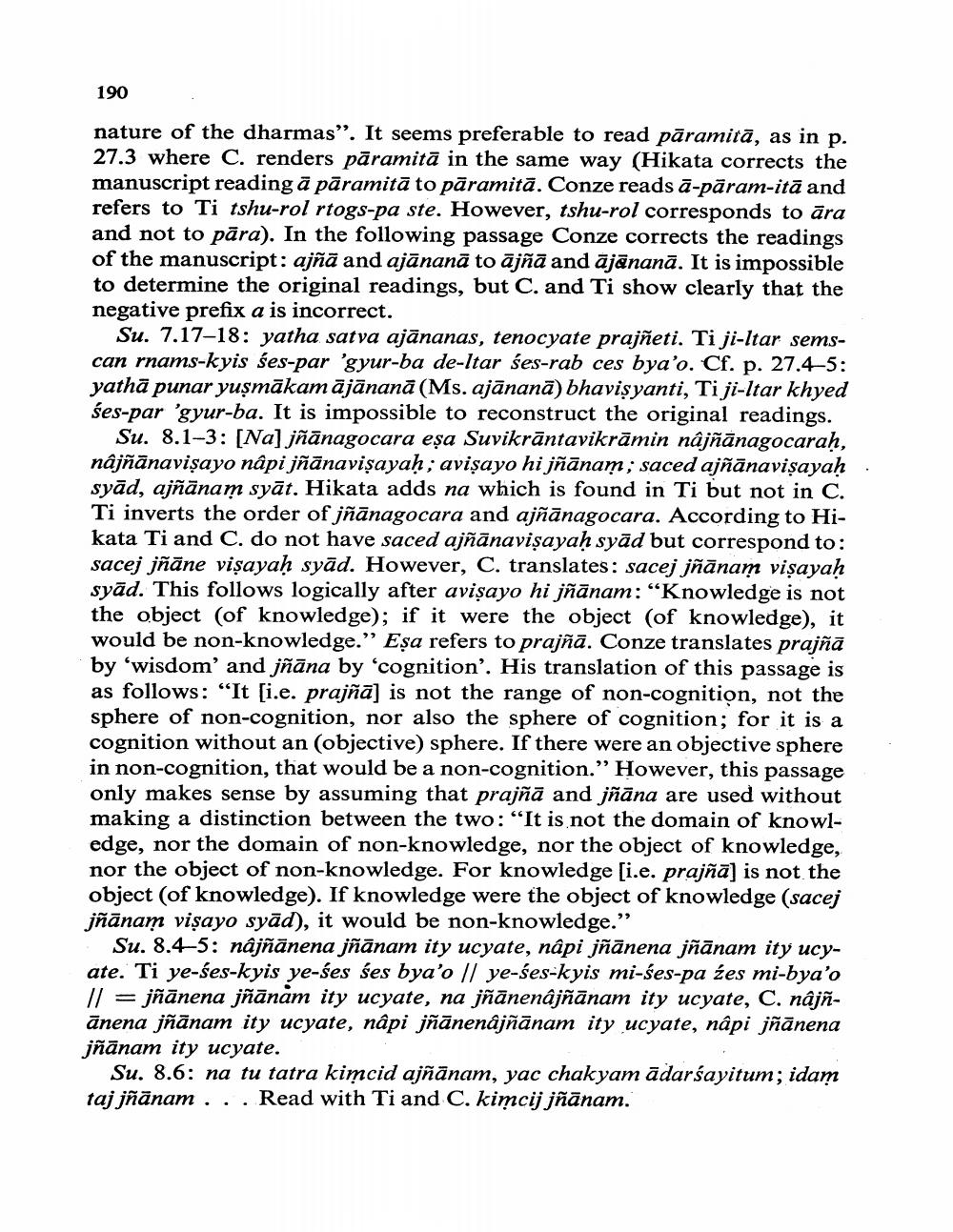Book Title: Notes On Prajnaparamita Texts Author(s): J W De Jong Publisher: J W De Jong View full book textPage 4
________________ 190 nature of the dharmas". It seems preferable to read pāramitā, as in p. 27.3 where C. renders pāramitā in the same way (Hikata corrects the manuscript reading ā pāramitā to pāramitā. Conze reads ā-pāram-itā and refers to Ti tshu-rol rtogs-pa ste. However, tshu-rol corresponds to āra and not to pāra). In the following passage Conze corrects the readings of the manuscript: ajñā and ajānanā to ājñā and ājānanā. It is impossible to determine the original readings, but C. and Ti show clearly that the negative prefix a is incorrect. Su. 7.17-18: yatha satva ajānanas, tenocyate prajñeti. Ti ji-ltar semscan rnams-kyis ses-par 'gyur-ba de-ltar śes-rab ces bya'o. Cf. p. 27.4-5: yathā punar yuşmākamājānanā (Ms.ajānanā) bhavisyanti, Ti ji-ltar khyed śes-par 'gyur-ba. It is impossible to reconstruct the original readings. Su. 8.1-3: [Na] jñānagocara eșa Suvikrāntavikrāmin nâjñānagocaraḥ, nâjñānavişayo nâpi jñānavişayaḥ; avişayo hi jñānam; saced ajñānavişayah. syād, ajñānam syāt. Hikata adds na which is found in Ti but not in C. Ti inverts the order of jñānagocara and ajñānagocara. According to Hikata Ti and C. do not have saced ajñānavişayaḥ syād but correspond to: sacej jñāne vişayah syād. However, C. translates: sacej jñānam visayah syād. This follows logically after avisayo hi jñānam: “Knowledge is not the object of knowledge); if it were the object (of knowledge), it would be non-knowledge.” Eşa refers to prajñā. Conze translates prajñā by 'wisdom' and jñāna by 'cognition'. His translation of this passage is as follows: "It [i.e. prajñā] is not the range of non-cognition, not the sphere of non-cognition, nor also the sphere of cognition; for it is a cognition without an (objective) sphere. If there were an objective sphere in non-cognition, that would be a non-cognition.” However, this passage only makes sense by assuming that prajñā and jñāna are used without making a distinction between the two: "It is not the domain of knowledge, nor the domain of non-knowledge, nor the object of knowledge, nor the object of non-knowledge. For knowledge [i.e. prajñā] is not the object (of knowledge). If knowledge were the object of knowledge (sacej jñānam visayo syād), it would be non-knowledge.” Su. 8.4-5: nâjñānena jñānam ity ucyate, nâpi jñānena jñānam ity ucyate. Ti ye-ses-kyis ye-ses ses bya'o // ye-ses-kyis mi-ses-pa zes mi-bya'o 11 = jñānena jñānam ity ucyate, na jñānenájñānam ity ucyate, C. nâjňānena jñānam ity ucyate, nâpi jñānenäjñānam ity ucyate, nâpi jñānena jñānam ity ucyate. Su. 8.6: na tu tatra kimcid ajñānam, yac chakyam ādarśayitum; idam taj jñānam ... Read with Ti and C. kimcij jñānam.Page Navigation
1 2 3 4 5 6 7 8 9 10 11 12 13
